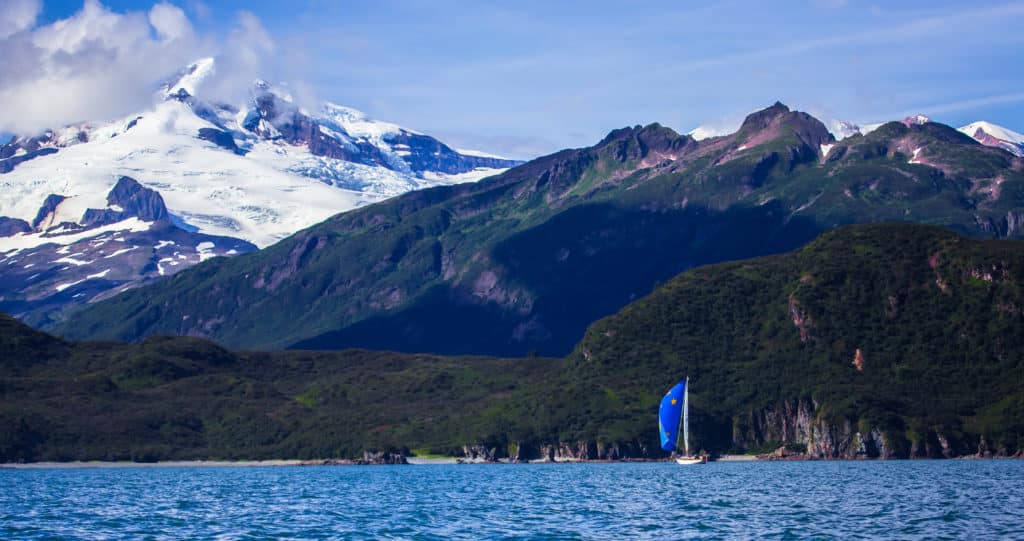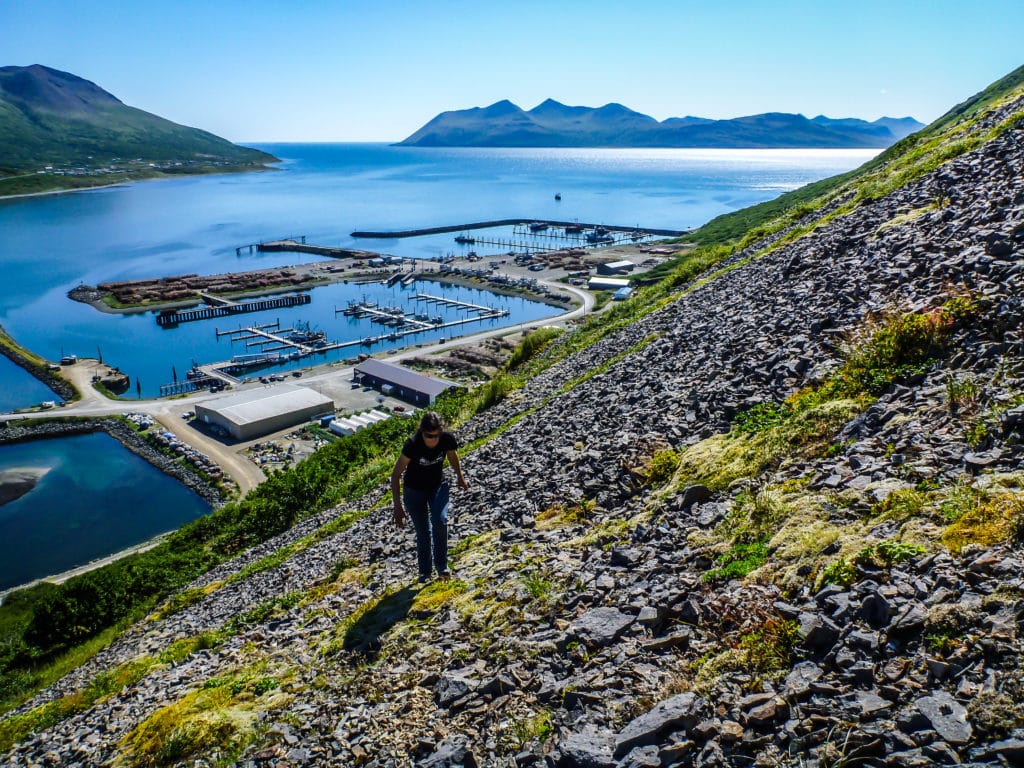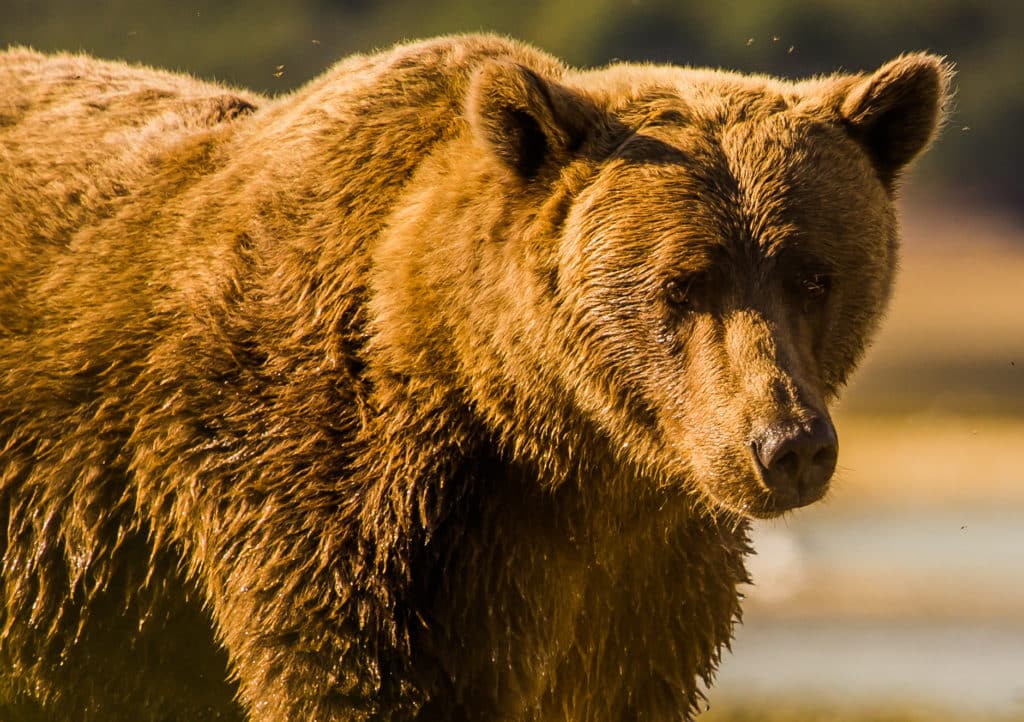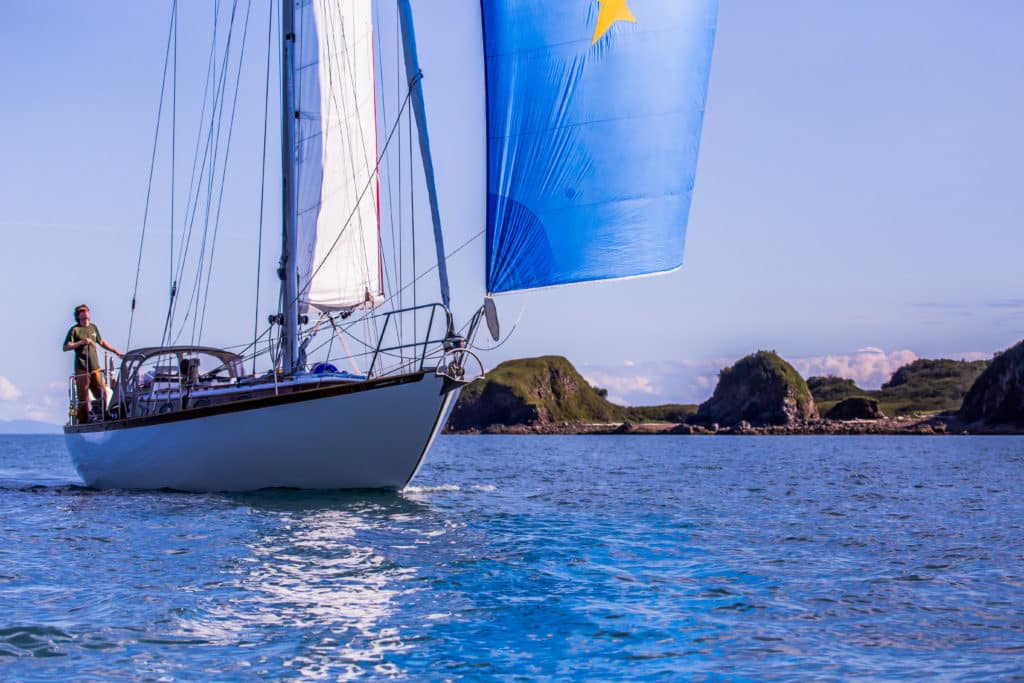
My husband, Seth, and I stood less than a yard from an Alaskan brown bear. We could see every hair on his body and his powerful muscles underneath. His claws stretched three inches out from his paws, and he was studying us with slightly bloodshot eyes. His nostrils flared to take in our scent. But then he turned back to the stream on whose bank all of us — humans and bear — were sitting or standing. He leaped into the river after a salmon. He missed it and charged again, back toward us! But his focus was concentrated on the spawning pinks, and this time he caught one. He started upstream, ignoring us as he passed so close I could see the blood run from where his jaws pierced the fish. Geographic Harbor was turning into an exciting place to be weather-bound.
By this point, Seth and I were a week into our cruise of the Alaska Peninsula aboard our cold-molded cutter, Celeste. The peninsula and Aleutian Islands were the last leg of our 2014 cruise. It was the portion for which we’d had the fewest expectations, and it was turning into the most memorable by far.
This region of rocks, wind and currents deserves its reputation for difficult voyaging. It’s rarely visited by cruising yachts, partly because of the conditions and partly because — unless you’re crossing from Japan to America — it’s not on the way to anywhere. Seth and I had faced the gales and short weather windows of New Zealand and the Cape of Good Hope, but opportunities to progress westward here were fewer and farther between. If we missed one, we could be stuck for a very long time. We were finding the Alaska Peninsula to be a quite formidable teacher of high-latitude sailing skills.
All-weather anchorages along this coast are scarce and poorly charted. Seth and I were lucky to have tips from local friends and sailors who were familiar with the region. Originally, we had planned to sail from Kenai Fjords, cruising along the Alaska Peninsula to the Aleutians with stops in Kukak Bay, Geographic Harbor, Agripina Bay, Chignik, Sand Point and King Cove before leaving Celeste for the winter in Unalaska (also commonly known as Dutch Harbor). But the weather didn’t want to cooperate.
At first it wasn’t bad. We left the Kenai Peninsula in light air, taking the most direct route, 130 nautical miles to Kukak Bay between the Barren Islands and Afognak, the island just north of Kodiak. We were soon engulfed in fog, listening for fishing boats until the wind died and our Yanmar drowned them out. I passed the Barren Islands in my graveyard watch, the sea heaving sickeningly despite the calm. We learned later from fishermen that the safer course would have been the less direct one, north of the islands, as standing waves can form between the islands when the tide sets against a blow.

Dawn brought one of the most spectacular landfalls in our 35,000 nautical miles to date. Mountains gripped in ice climbed into the sky, dusted by alpenglow. A layer of fog clung to the shore, so that the glaciers seemed to float above the sea. As the sun rose, a 10-knot breeze sprang up on our quarter, and Celeste bowled down to Kukak Bay under spinnaker. The wilderness around us — striking, glaciated and immense — felt as if it was likely unchanged since mammoths roamed its hills. A bend in the bay revealed a vast river delta, utterly deserted. Awe-inspiring as it was, this delta also made anchoring tricky: Its sands extended a long way out and then abruptly dropped off. We were finally able to anchor in about 17 feet, and as we settled down to dinner, an enormous brown bear ambled down the beach astern of us.
We woke to a still and shining world. Given that such weather doesn’t usually happen here in August, or at all, we probably should have pushed onward. Instead we explored ashore. I’ve experienced the immensity of an ocean crossing and the forbidding beauty of high peaks, but as I stepped onto the sand, I knew this was something different. Nowhere else have I felt so small in such a vast wilderness — one that truly belongs to the bears and wolves whose myriad prints crisscrossed the delta. I couldn’t help thinking that this feeling of acutely sharpened senses must have been a permanent state for the people who’d crossed from Siberia thousands of years ago.
The fair weather held the next day, so we beat to Geographic Harbor against 15-knot winds and a 1-knot current. The 35-mile sail was within Shelikof Strait, which runs between the Alaska Peninsula and Kodiak Island and is a body of water universally abhorred by seasoned fishermen. Their tactic to avoid the tidal currents and washing-machine seas is to hug the coast, advice we heeded to our benefit.
Geographic Harbor is nearly landlocked, and a poorly charted rock makes the narrow entrance nerve-wracking. To seaward, a small archipelago breaks the swell, so you have little idea of conditions in Shelikof Strait when inside the harbor. The mountains rimming the bay also cut off VHF signals, so it was difficult to get NOAA forecasts. Of course, all this makes Geographic Harbor ideally sheltered, but when the weather deteriorated outside, we were blissfully unaware.
We saw several brown spots moving along a stream on our way in, and as we anchored, I spotted some ruffled fur and two ears in the water astern of us: a bear swimming! Thinking we would have only one day in Geographic Harbor, we launched the dinghy to observe the wildlife. Our swimming bear was preening himself in the shallows. We carefully approached the stream, where I counted eight more bears fishing. Two of them were mothers with cubs. The mothers were piling their catch on the bank, but the cubs — like children everywhere — seemed more interested in playing than eating dinner with Mom.

Once underway in the morning, we found 40-knot winds and steep waves tearing across Shelikof Strait. NOAA predicted worsening conditions, followed by a more moderate low, 25 knots from the southeast, in a few days’ time. We returned to Geographic Harbor.
Our solitude was broken the next day by a tourist boat bearing a “photo safari.” Seth and I were at first horrified and then intrigued: A skiff took passengers ashore, where they set up their tripods just yards from the fishing bears! An hour went by with the bears unfazed. We grew envious of their photos and decided we’d follow suit, armed with bear spray. The eight guests and their guide, an Alaskan biologist, welcomed us. Within minutes, the huge male bear was a yard from my face. The guide sensed my fear and murmured not to move. I knew he was right, and as the morning went on and four more bears passed close, I was amazed to find myself relaxing and appreciating these incredible encounters.
Seth and I stayed at anchor that night, inviting the biologist and the boat’s captain to drinks, and attempted to leave again in the morning. The predicted 25-knot southeasterly turned into a 35-knot southwesterly, so again we retreated. A brief consultation with the tour boat’s captain about common weather conditions revealed that we’d have to grin and bear it. Another low was coming with southeast winds; we knew we had to take it all the way to Sand Point, skipping Agripina Bay and Chignik, if we ever wanted to reach Unalaska.
The following day found us tearing before 35 knots, spray whisking from the whitecaps around us. As night fell, the wind increased to 40 and then 45 knots, so we doused the triple-reefed main and flew only the high-cut yankee jib. The forecast was puzzling. NOAA divides Alaska into weather zones, and our two zones, Shelikof Strait and Sitkinak to Castle Cape, had wildly different predictions. Yet sure enough, as we passed between them, 35-knot head winds greeted us. Despite clear skies, the blow built all day, until gusts funneling out of the bays and between mountains hit 50 knots. The whole sea foamed white. Spray drove over the top of the boom. Celeste’s bow submerged in every wave, and her jib sheet and windward shrouds were taut as piano strings. We debated turning back for Agripina Bay, but we were 30 miles past it already. Chignik was not protected enough, but a place on the chart called Ross Cove might be. Our chart didn’t give elevations, so we didn’t know how wrong we were.
The thousand-foot cliffs guarding Ross Cove were reminiscent of Dante’s eighth circle of hell, and the wind funneling between them made our 50-knot gusts look pleasant. Clouds of spray flew high into the air at the head of the cove: terrifying, hurricane-force williwaws.
We did what the weather commanded and swung the bow 180 degrees, steeling ourselves for another windy night at sea. I dug out a just-add-boiling-water meal to fortify us. Almost as soon as we’d eaten it, the wind lay down. We raised the main, and an hour later it was slatting as Celeste rolled in a calm. I overstayed my turn at the helm by two hours that night, watching the silhouetted mountains pass by as our engine hummed. Around 0500, I noticed a greenish glow in the sky and assumed it was dawn. Then the glow brightened and started to dance: It was the aurora.

Sand Point, which we reached that afternoon, at first looked forlorn, its small, brightly painted houses scattered over the tundra. But when we rounded the breakwater, we were astounded to find a beautiful new marina, provided by the state for the fishing fleet. We stayed only one day, but that was long enough to explore town, buy vegetables, and be invited by three different strangers to the Salmon Derby dinner.
We were sad to leave, but we’d learned our lesson about weather. Light and variable winds were forecast for the next day, so we left at 0430 to cover the 75 miles to King Cove in daylight. Dawn brought low clouds and a 20-knot northerly on the beam. Celeste threaded between the mainland and the Shumagin and Pavlof islands, keeping to the channel. Beyond lay a reef thick with poorly surveyed rocks, so even the fishermen don’t stray from the buoys. The sky gradually cleared, and we hoped to glimpse Pavlof Volcano, the 8,000-foot peak that had last erupted a few months before our visit. But it stubbornly refused to reveal its top, so we contented ourselves with the puffins floating around Celeste.
As we crossed the open water toward Deer Passage, the sun came out, the wind slackened, and a pod of humpback whales approached. One giant surfaced just yards from Celeste. Seth and I abandoned the helm to the autopilot and stood on the foredeck watching. Two whales started lifting their heads out of the water and then fully breached, again and again.
As abruptly as they’d come, they left. Equally suddenly, the wind was back in force, which was no surprise to us anymore. By now we’d learned how quickly conditions could change and how much flexibility and readiness were required to sail these waters. Turning into King Cove, we tacked against the funneling north wind and entered the fishing basin. We took a slip next to a gill-netter, and before the night was out, we were fast friends with the crew.
Seth and I had known little about King Cove. We’d stopped because it was a convenient jump-off point for our last passage to Unalaska. Perhaps because of this, it was one of our favorite ports. Sheltered between volcanic peaks at the edge of a vast lagoon, the village has no road access. Scrub bush covers the lower slopes, and above is open tundra. Seth and I fought our way through the scrub, scrambled over rock screes, and finally gained the top of a ridge.
Below us stretched a green, untouched valley, different in its vegetation from Kukak Bay, where we had also hiked, but the same in its immense wildness. The whole Pacific lay before us, and to the southwest stood the end of the peninsula. The mountainous Aleutian Islands pierced the sky beyond. To the north we beheld for the first time the sea where we were bound, the Bering.
As we walked along the ridge, a golden eagle — the eagle of Europe and Siberia — swooped below us. Ends of the earth? This was it.
Watch the first episode of Gone Floatabout here, and stay tuned for more videos from Ellen and Seth’s travels!
Ellen Massey Leonard completed a global circumnavigation at age 24 and recently sailed her classic cutter to the northernmost tip of America, in the Alaskan Arctic. She chronicles her adventures at gonefloatabout.com.
Read More: Cold Weather Cruising | Cruising Alaska | Gone Floatabout Videos








